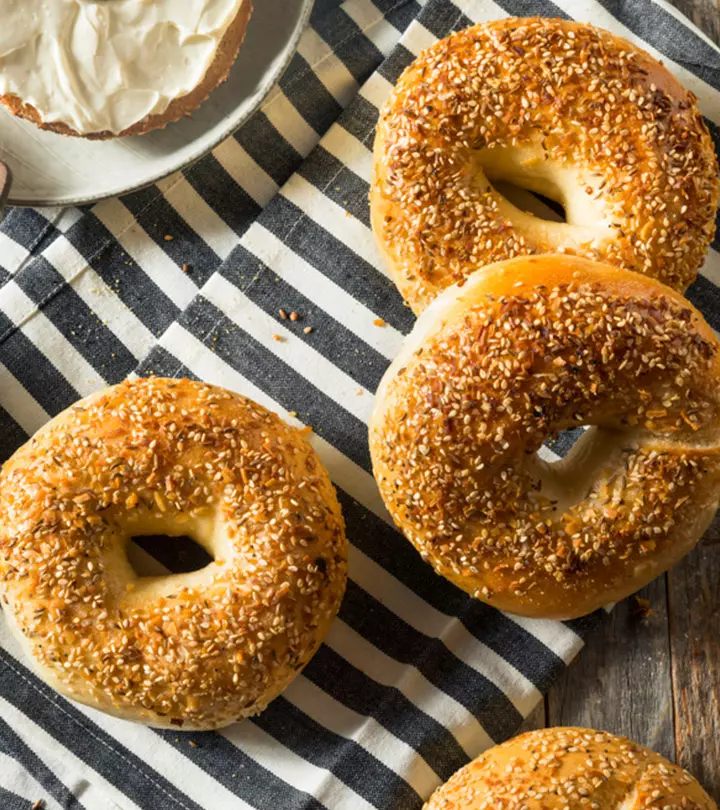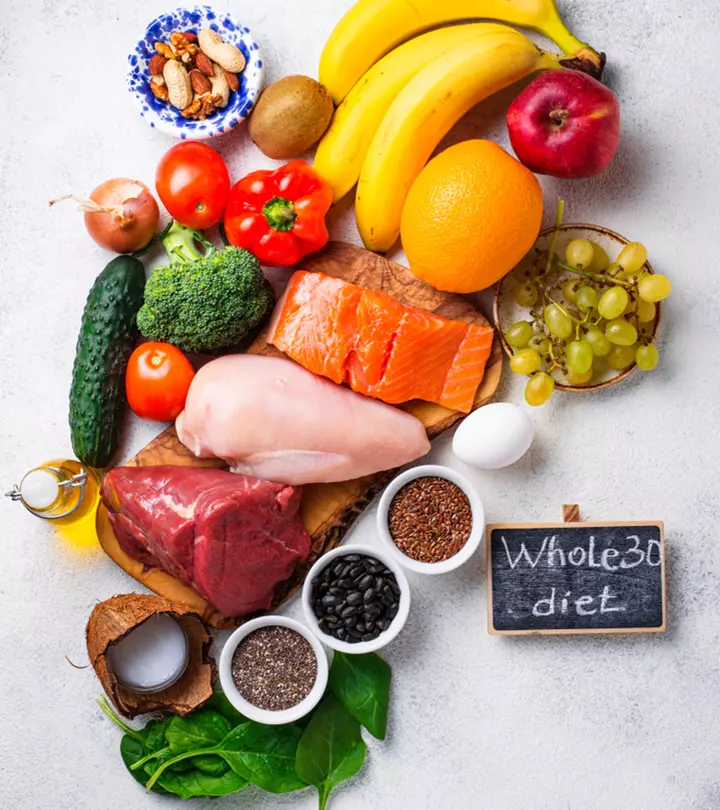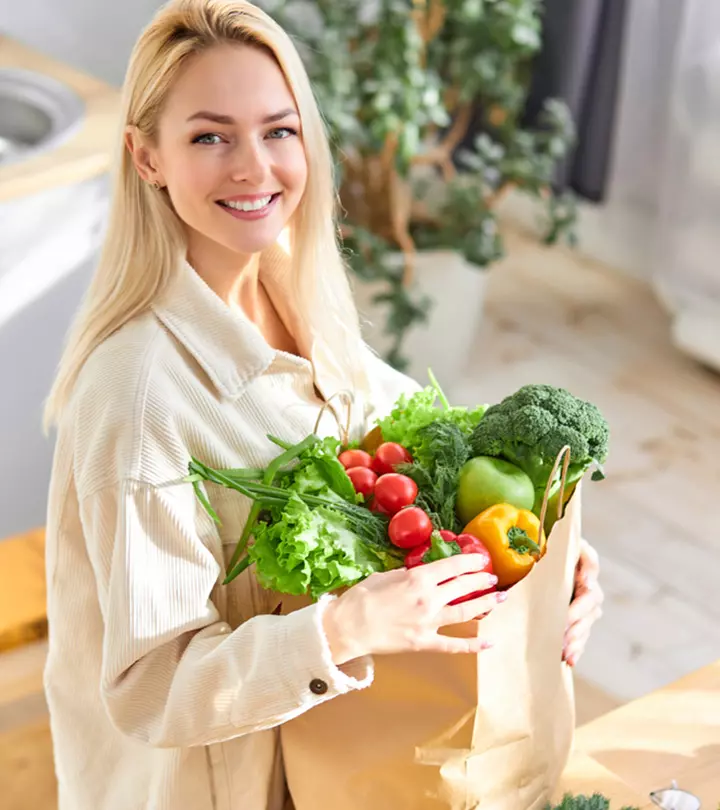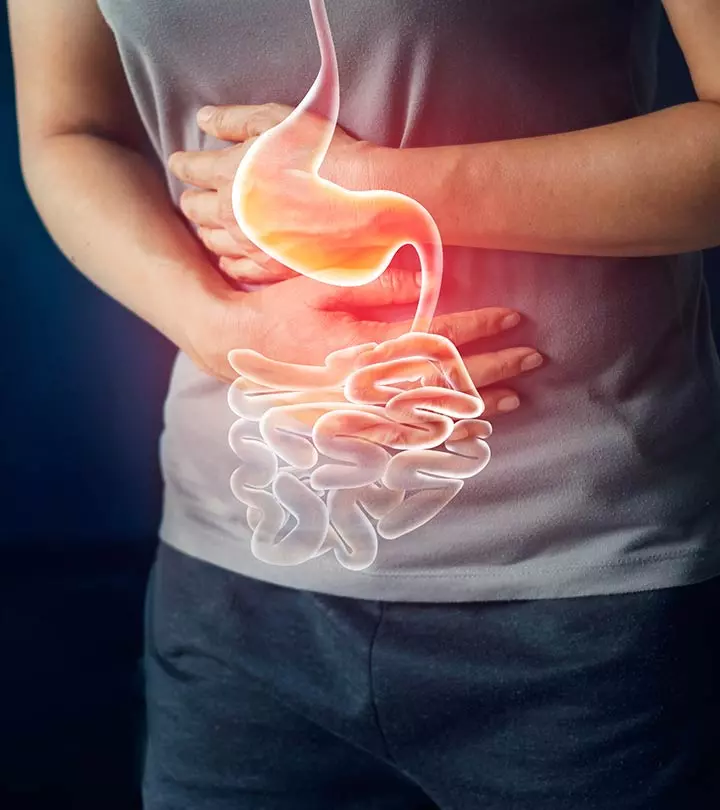DASH Diet: 5 Science-Backed Benefits, Foods To Eat And Avoid
Learn all about this science-based diet that can help manage your BP levels.

Image: Shutterstock
The DASH diet is a science-backed dietary approach to reduce high blood pressure (1). About 1.13 billion people worldwide have hypertension, which puts them at a higher risk of heart disease and organ damage (2), (3). Making a conscious effort to change the lifestyle and consuming low-sodium foods can help reduce high blood pressure and the risk of comorbidities. In this article, you will learn about the DASH diet, its benefits, a sample diet chart, foods to eat and avoid, and other associated concerns. Read on!
In This Article
What Is The DASH Diet According To The Experts?
The DASH diet (meaning Dietary Approaches to Stop Hypertension) originated in the 1990s to reduce high blood pressure through dietary intervention (1). Ashley Larsen, RDN, says, “This is a balanced diet approach that is low in sodium and fat, and high in important nutrients, such as calcium, potassium, magnesium, and fiber, which has been proven to lower blood pressure.”
Kristen Kuminski, RD, CDN, a New York-based registered dietitian, says, “It’s similar to a Mediterranean diet, which emphasizes plant-based foods like fruits, vegetables, legumes, nuts, seeds, and whole grains.” She adds, “The DASH diet is lower in sodium because it avoids processed foods like deli meats, canned soups, etc. It also emphasizes lean proteins and foods with heart-healthy unsaturated fats like salmon over red meat, which is higher in saturated fats.”
The claims about the efficacy of the DASH diet are scientifically backed. This diet is believed to be one of the best and effective diets. It is proven to be beneficial for reducing high blood pressure and preventing hypertension-related diseases and conditions. Scroll down to the next section to know about its benefits.
Key Takeaways
- The DASH diet is a well-balanced diet that is rich in fruits and vegetables and low in sodium and saturated fat.
- This diet is recommended as an effective plan for managing diabetes.
- It also helps maintain weight, reduce the risk of cardiovascular diseases, and manage certain types of chronic kidney diseases that are impacted by too much sodium.
- Though it has some minor temporary side effects early on, your body may take time to adjust to this diet plan.
Science-Backed DASH Diet Benefits
1. Reduces Blood Pressure
The DASH diet recommends reducing your sodium intake. A low sodium diet or low salt diet helps reduce excess water in the blood vessels (4). This decreases blood volume and the pressure on the blood vessel walls to reduce hypertension.
Analyzing NHANES 2017–2018 data, a study with 4730 participants revealed a hypertension prevalence of 45.6% under the American College of Cardiology/American Heart Association (ACC/AHA) 2017 guidelines. Among them, 21.0% maintained controlled blood pressure. The most significant absolute increases in hypertension and controlled hypertension rates were observed in individuals aged 40–59 years.
A study conducted on 459 adults with hypertension who followed the DASH diet for 11 weeks showed that a diet rich in vegetables, fruits, low-fat, and low saturated fat helped reduce hypertension (5).
2. Prevents Cardiovascular Diseases
Cardiovascular diseases (CVD) are closely associated with hypertension. Approximately 54% of strokes and 47% of coronary heart diseases in the world are caused due to high BP (6). A DASH diet intervention on 1917 participants for 2-24 weeks showed a significant decrease in systolic and diastolic blood pressure, proving it an effective nutritional strategy to reduce CVD risk (7).
3. Manages Type 2 Diabetes
About 50% of people with type 2 diabetes have high blood pressure (8). They are also at a higher risk of CVD (cardiovascular disease). Therefore, it is important to reduce blood pressure and manage type 2 diabetes. The foods allowed in the DASH diet are nutritious and low in sodium. Moreover, it restricts the intake of refined carbohydrates. The American Diabetes Association recommends the DASH diet as a part of the diabetes management plan to reduce insulin resistance (9).
4. Manages Chronic Kidney Disease
Kristen Kuminski, RD, CDN, says, “The DASH Diet is beneficial for healthy kidney function.” The National Kidney Foundation recommends the DASH diet to reduce the risk of kidney stones (10). A commentary published in the journal Kidney International reports that the DASH diet may have an important role in preventing end-stage kidney disease in select individuals with chronic kidney disease (11).
5. Weight Management
The DASH diet is also a great way to reduce weight and manage obesity. It is more effective than other low-calorie diets and may help reduce BMI (12). A study involving people with non-alcoholic fatty liver showed that an 8-week DASH diet intervention helped reduce their weight, BMI, and inflammation and improved blood lipid profiles and insulin sensitivity (13).
 Trivia
TriviaA blogger who tried the DASH diet with her husband shares, “We’ve now been in Phase 2 for a little over a week, we feel great, and I’ve lost another 2 pounds. I don’t constantly crave sugar or junk food. In fact, I actually crave healthy foods, and I get a stomachache even if I eat more than modest amounts of rice, pasta, or bread. Apples and bananas taste incredibly sweet (and satisfying!) to me. I get full faster. I have more restraint and self-control with food. I have more energy (i).”
Clearly, the DASH diet has been studied well. It has many health benefits that help improve life span and the quality of life. In the next section, you will find a list of recommended foods for the DASH diet. Take a screenshot or pin it to refer to the list when you shop for your groceries. Scroll down.
Recommended Foods On DASH Diet
The DASH diet emphasizes consuming more fruits, veggies, grains, and nuts, limiting sodium consumption to 1500-2300 mg per day, and avoiding or limiting processed foods. Dr. Kristina Hendija says, “The diet restricts sodium, sugar, and saturated fats, which are all bad for hypertension.” Here’s a list of foods recommended in the DASH diet within 2000 calories, as per the National Heart, Lung, and Blood Institute (14):

- Vegetables (4-5 servings a day): Broccoli, carrot, spinach, kale, arugula, cabbage, purple cabbage, cauliflower, bell peppers, scallion, chive, okra, chard, beetroot, squash, bottle gourd, and Brussel sprouts.
- Fruits (3-4 servings a day): Apple, pear, peach, banana, berries, avocado, and oranges.
- Lean Meats, Poultry, And Fish (6-8 oz per day): Skinless chicken breast, lean cuts of beef, ground turkey, egg white, tuna, salmon, sea bass, haddock, mackerel, and carp.
- Grains (6-8 servings a day): Whole wheat bread, brown rice, bulgur, oatmeal, and quinoa.
- Healthy Fats: Olive oil, avocado oil, rice bran oil, peanut butter, sunflower butter, and almond butter.
- Fat-free Or Low-Fat Dairy Products (2-3 servings a day): Skim milk, low-fat yogurt, and 1½ ounces of low-fat cheese.
- Nuts, Seeds, And Legumes (4-5 servings a week): Lentils, kidney beans, garbanzo beans, black-eyed peas, peanuts, almonds, walnuts, macadamia, pecans, sunflower seeds, chia seeds, pepita, and flax seeds.
- Sweets And Added Sugars (5 servings or fewer a week): Low-sugar jam and jelly, sorbet, and lemonade.
 Quick Tip
Quick TipFor beginners, this list can seem a little intimidating. Don’t worry. Here’s a sample diet menu plan for you to understand what and how much of DASH diet-compliant foods to consume.
| Meals | What To Eat |
|---|---|
| Breakfast | Egg and avocado toast topped with seeds + tea/coffee/fruit juice Or Tofu scramble with bell peppers and spinach + tea/coffee/fruit juice |
| Lunch | 5 oz baked fish/tofu +1 cup raw leafy green vegetable, ½ cup of raw or cooked vegetables + 1 cup of low-fat yogurt |
| Snack | ½ cup of sorbet or 1 cup of lemonade Or 1/3 cup of mixed unsalted nuts Or ½ cup of fruit juice |
| Dinner | ½ cup of cooked legumes + 1 cup of raw leafy green vegetable, ½ cup of raw or cooked vegetables + 1 cup low-fat milk before bed |
The foods list and DASH diet menu plan can help you lower your sodium intake to a great extent. However, you must also know which foods to avoid for effective results. The following section lists out foods that you must avoid if you have high blood pressure. Take a look.
Foods To Avoid On DASH Diet
As a rule of thumb, avoid consuming foods with high sodium, high-saturated fat, or of zero nutritional value. Diana Gariglio-Clelland, Registered Dietitian & Certified Diabetes Care & Education Specialist, says, “Avoid processed foods like deli meats, canned soups, etc.” She also recommends avoiding high-fat red meat. The below list is a reminder of what to NOT eat on the DASH diet:
- High-Sodium Foods: Frozen foods, fries, pizza, salted nuts, cured meats, canned pasta, packaged sauces, canned foods, pickles, and kimchi.
- Processed Foods: Ready-to-eat meals, sausages and salamis, ham, bacon, breakfast cereals, biscuits, and chips.
- Saturated Fats: Red meat, lard, butter, mayonnaise, margarine, palm oil, coconut oil, vegetable oil, fatty cuts of meat, and pancetta.
- Refined Carbs: White sugar, white flour, white rice, white bread, bagel, wafers, cakes, pastries, pies, and pate.
- Full-Fat Dairy And Dairy Products: Whole milk, milk cream, full-fat yogurt, flavored yogurt, and cheese.
Note
: People with nut allergies can avoid nuts and consume avocado or other healthy sources of fats like fatty fish, seeds, and olive oil.
The next section will take you through a DASH diet-friendly recipe that do not include these foods. Check it out.
DASH Diet Recipe
Rainbow Vegetable Soup

Ingredients
- 1 tablespoon olive oil
- 1 onion, diced
- 2 carrots, sliced
- 2 celery stalks, chopped
- 1 bell pepper, diced
- 1 cup of broccoli florets
- 1 cup kale, chopped
- 3 cloves garlic, minced
- 1 tablespoon of olive oil
- 6 cups of low-sodium vegetable broth
- 1 teaspoon of thyme
- ½ teaspoon of black pepper
- ½ teaspoon of paprika
- 1 teaspoon of lemon juice
How To Prepare
- Heat olive oil in a large pot and add onion, carrots, celery, bell pepper, garlic, thyme, black pepper, and paprika.
- Saute for 5-7 minutes, and add the remaining vegetables and broth
- Bring to a boil, simmer for 15-20 minutes, and season with lemon juice.
Are there any side effects of the DASH diet? Find out in the following section.
Are There Any Side Effects?
The DASH diet does not have any side effects as such. However, your body may take time to adjust to a low-sodium diet with lots of whole foods. And while it adjusts, you may experience the following:
- Bloating (15)
- Mood swings
- Salt and sugar cravings
Once your body overcomes these “side effects,” you will be happy to consume foods that are good for your body and mind. But is the DASH diet for everyone or is it only for people with high blood pressure levels? Let’s find out.
Is The DASH Diet For Everyone?
, Associate Professor Emeritus of Pediatrics at Albert Einstein College of Medicine, New York, says, “It works for the whole family, so there’s little need for specialized foods.” However, people who are prone to disordered eating or in recovery from an eating disorder should not embark on the DASH diet without consultation and medical supervision from their eating disorder treatment team.
Otherwise, what’s great is that if one of your family members needs to be on the DASH diet, everyone can switch to the DASH diet to support the family member and improve their food habits.
As per the American Heart Association, the DASH diet excludes foods that are rich in sodium and saturated fats, which increase blood pressure (16). Instead, it favors foods rich in potassium, calcium, magnesium, and fiber that have anti-hypertension effects. Moreover, it excludes refined carbohydrates, which help manage or reduce the risk of type-2 diabetes. This diet also eliminates all processed foods and recommends lean meat over high-fat red meat. The best thing about them is that anyone can follow this diet, although it was specifically designed for hypertension and obesity. However, your body may take time to adjust to the DASH diet, and some people may experience temporary bloating, mood swings, and sugar and salt cravings initially.
Frequently Asked Questions
Can I follow the DASH diet as a vegetarian?
Absolutely! You can easily adapt the DASH diet to a vegetarian or vegan lifestyle. Focus on plant-based protein sources like beans, lentils, tofu, and tempeh. Include plenty of fruits, vegetables, and whole grains.
Can drinking alcohol increase blood pressure?
Yes. Drinking too much alcohol can increase blood pressure. It is best to limit your alcohol intake to 1 glass of wine per day and then cut it down to 1 glass per week.
Do I need to exercise on the DASH diet?
Yes, you can exercise on the DASH diet if your doctor allows you to. Exercising is good for your physical and mental health.
What is the recommended daily allowance of sodium?
The recommended daily allowance of sodium is 1500-2300 mg per day.
What is the normal blood pressure range?
Normal blood pressure is considered less than 120/80 mmHg.
What is the hypertension blood pressure range?
The hypertension blood pressure range is 140/90 mmHg or more, according to the American Heart Association.
Learn to use whole-grain flour and potassium-rich bananas while controlling salt intake. Discover a 28-Day Dash Diet for developing a sensible approach to lowering blood pressure. Check out the video now.
Personal Experience: Source
StyleCraze's articles are interwoven with authentic personal narratives that provide depth and resonance to our content. Below are the sources of the personal accounts referenced in this article.
(i). The DASH Diet: Our Experiencehttps://lizspangler.blogspot.com/2014/03/the-dash-diet-our-experience.html
References
Articles on StyleCraze are backed by verified information from peer-reviewed and academic research papers, reputed organizations, research institutions, and medical associations to ensure accuracy and relevance. Read our editorial policy to learn more.
- DASH Diet To Stop Hypertension
https://www.ncbi.nlm.nih.gov/books/NBK482514/ - Hypertension
https://www.who.int/news-room/fact-sheets/detail/hypertension - Hypertension
https://www.ncbi.nlm.nih.gov/pmc/articles/PMC6477925/ - Sodium Intake and Hypertension
https://www.ncbi.nlm.nih.gov/pmc/articles/PMC6770596/ - The Long-Term Effects of Lifestyle Change on Blood Pressure: One-Year Follow-Up of the ENCORE Study
https://www.ncbi.nlm.nih.gov/pmc/articles/PMC3978946/ - High Blood Pressure and All-Cause and Cardiovascular Disease Mortalities in Community-Dwelling Older Adults
https://www.ncbi.nlm.nih.gov/pmc/articles/PMC5059018/ - Effects of the Dietary Approach to Stop Hypertension (DASH) diet on cardiovascular risk factors: a systematic review and meta-analysis
https://pubmed.ncbi.nlm.nih.gov/25430608/ - Type 2 diabetes mellitus and hypertension: An update
https://www.ncbi.nlm.nih.gov/pmc/articles/PMC3942662/ - DASH Eating Plan: An Eating Pattern for Diabetes Management
https://spectrum.diabetesjournals.org/content/30/2/76 - The DASH Diet
https://www.kidney.org/kidney-topics/dash-diet - The Dietary Approaches to Stop Hypertension (DASH) diet in chronic kidney disease: should we embrace it?
https://pubmed.ncbi.nlm.nih.gov/31122706/ - The effect of dietary approaches to stop hypertension (DASH) diet on weight and body composition in adults: a systematic review and meta-analysis of randomized controlled clinical trials
https://pubmed.ncbi.nlm.nih.gov/26990451/ - The effects of DASH diet on weight loss and metabolic status in adults with non-alcoholic fatty liver disease: a randomized clinical trial
https://pubmed.ncbi.nlm.nih.gov/26503843/ - DASH Eating Plan | NHLBI, NIH
https://www.nhlbi.nih.gov/education/dash-eating-plan - Effects of the DASH Diet and Sodium Intake on Bloating: Results From the DASH–Sodium Trial – PMC
https://www.ncbi.nlm.nih.gov/pmc/articles/PMC7122060/ - Managing Blood Pressure with a Heart-Healthy Diet
https://www.heart.org/en/health-topics/high-blood-pressure/changes-you-can-make-to-manage-high-blood-pressure/managing-blood-pressure-with-a-heart-healthy-diet
Read full bio of Eleana Kaidanian
Read full bio of Ravi Teja Tadimalla
Read full bio of Aparna Mallampalli


























Community Experiences
Join the conversation and become a part of our empowering community! Share your stories, experiences, and insights to connect with other beauty, lifestyle, and health enthusiasts.